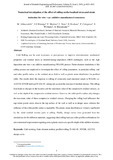JavaScript is disabled for your browser. Some features of this site may not work without it.
| dc.contributor.author | Abbaszadeh, Masoud | |
| dc.contributor.author | Hönnige, J. R. | |
| dc.contributor.author | Filomeno, Martina | |
| dc.contributor.author | Kashaev, N. | |
| dc.contributor.author | Colegrove, Paul A. | |
| dc.contributor.author | Williams, Stewart W. | |
| dc.contributor.author | Klusemann, B. | |
| dc.date.accessioned | 2019-08-21T15:45:18Z | |
| dc.date.available | 2019-08-21T15:45:18Z | |
| dc.date.issued | 2019-08-16 | |
| dc.identifier.citation | Abbaszadeh M, Hönnige JR, Martina F, et al., (2019) Numerical investigation of the effect of rolling on the localized stress and strain induction for wire + arc additive manufactured structures. Journal of Materials Engineering and Performance, Volume 28, Issue 8, August 2019, pp. 4931-4942 | en_UK |
| dc.identifier.issn | 1059-9495 | |
| dc.identifier.uri | https://doi.org/10.1007/s11665-019-04249-y | |
| dc.identifier.uri | https://dspace.lib.cranfield.ac.uk/handle/1826/14454 | |
| dc.description.abstract | Cold rolling can be used in-process or post-process to improve microstructure, mechanical properties and residual stress in directed-energy-deposition techniques, such as the high deposition rate wire + arc additive manufacturing (WAAM) process. Finite element simulations of the rolling process are employed to investigate the effect of rolling parameters, in particular rolling load and roller profile radius on the residual stress field as well as plastic strain distribution for the profiled roller. The results show the response to rolling of commonly used structural metals in WAAM, i.e., AA2319, S335JR steel and Ti-6Al-4V, taking into account the presence of residual stresses. The rolling load leads to changes in the location and the maximum value of the compressive residual stresses, as well as the depth of the compressive residual stresses. However, the roller profile radius only changes the maximum value of these compressive residual stresses. Changing the rolling load influences the equivalent plastic strain close to the top surface of the wall as well as in deeper areas, whereas the influence of the roller profile radius is negligible. The plastic strain distribution is virtually unaffected by the initial residual stresses prior to rolling. Finally, design curves were generated from the simulations for different materials, suggesting ideal rolling load and roller profile combinations for microstructural improvement requiring certain plastic strains at a specific depth of the additive structure. | en_UK |
| dc.language.iso | en | en_UK |
| dc.publisher | Springer Verlag | en_UK |
| dc.rights | Attribution 4.0 International | * |
| dc.rights.uri | http://creativecommons.org/licenses/by/4.0/ | * |
| dc.subject | AA2319 | en_UK |
| dc.subject | cold working | en_UK |
| dc.subject | design curve | en_UK |
| dc.subject | finite element method | en_UK |
| dc.subject | profiled rolling | en_UK |
| dc.subject | S355JR | en_UK |
| dc.subject | Ti-6Al-4V | en_UK |
| dc.title | Numerical investigation of the effect of rolling on the localized stress and strain induction for wire + arc additive manufactured structures | en_UK |
| dc.type | Article | en_UK |
Files in this item
The following license files are associated with this item:
This item appears in the following Collection(s)
-
Staff publications (SATM) [4365]

